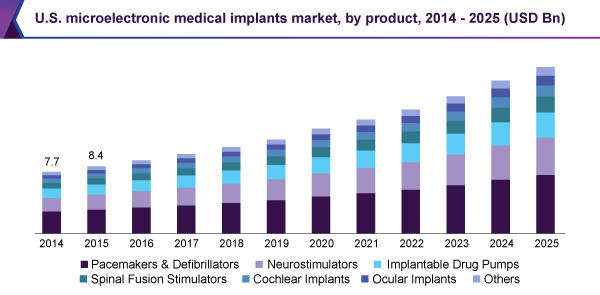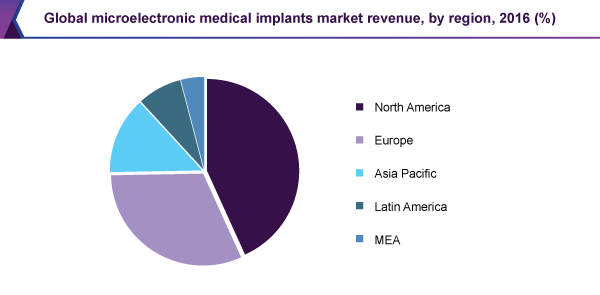- Home
- »
- Medical Devices
- »
-
Microelectronic Medical Implants Market, Industry Report, 2018-2025GVR Report cover
![Microelectronic Medical Implants Market Report]()
Microelectronic Medical Implants Market Analysis Report by Product (Pacemakers & Defibrillators, Neurostimulators, Implantable Drug Pumps, Spinal Fusion Stimulators), by Technology, And Segment Forecasts, 2018 - 2025
- Report ID: GVR-2-68038-318-8
- Number of Report Pages: 87
- Format: PDF, Horizon Databook
- Historical Range: 2014 - 2015
- Forecast Period: 2017 - 2025
- Industry: Healthcare
Report Overview
The global microelectronic medical implants market size was valued at USD 24.80 billion in 2016 and is expected to develop at a CAGR of 9.8% during the forecast period. Increasing prevalence of epilepsy, cardiac disorders, and Parkinson’s disease, rising geriatric population, growing number of regulatory approvals for new devices, and launch of new products are key factors driving market growth.

Growing incidence of cardiac disorders is playing a key role in the market for microelectronic medical implants. Cardiovascular diseases (CVDs) such as cardiac arrest, congestive heart failure, stroke, and coronary artery diseases often require implants such as pacemakers and defibrillators. According to WHO, CVDs are the leading cause of death globally and in 2015, accounted for 31.0% of global deaths. Of these, 6.7 million people died from a stroke and 7.4 million due to coronary heart disease.
Epilepsy, a neurological disorder wherein a patient experiences epileptic seizures, has also been on a rise, positively impacting demand for microelectronic medical implants. As per WHO, approximately 50 million people have been living epilepsy, making it one of the most common neurological disorders. The disorder can be treated using neurostimulators, which prevent seizures by sending regular and mild pulses of electrical energy to the brain through the vagus nerve.
Parkinson’s disease (PD) is a degenerative disorder of the central nervous system, which affects the motor system. As per the Parkinson’s Foundation, approximately one million Americans live with PD and around 60,000 Americans are diagnosed with PD each year. Deep brain stimulation (DBS) is a surgery performed to implant a pacemaker-like device, also known as a brain pacemaker, into the brain tissue to treat PD. Growing prevalence of these diseases is increasing the adoption of microelectronic medical implants, thereby propelling market growth.
Key players have been launching many new and innovative products equipped with the latest technology and design, which is increasing the competition in the market. For instance, in July 2017, Cochlear introduced a cochlear implant sound processor for iPhones. This implant can stream audio from a compatible iPod, iPad, or iPhone directly to a surgically embedded sound processor. In March 2017, BIOTRONIK launched the smallest and lightest MR-Conditional pacemaker and a new range of Quadripolar CRT-Ps in Europe. These new products are equipped with features that improve patient therapy, comfort, and safety.
Product Insights
On the basis of product, the market for microelectronic medical implants is segmented into pacemakers and defibrillators, neurostimulators, implantable drug pumps, spinal fusion stimulators, cochlear implants, ocular implants, and others. Pacemakers and defibrillators held the largest market share in 2016, owing to increasing incidence of cardiac diseases and rising geriatric population. Common conditions for which a patient may require a pacemaker are heart blockage and bradycardia.
Doctors may also recommend a pacemaker in cases of Long QT Syndrome (LQTS), heart muscle problems resulting in slow travel of electric signals to the heart muscle, slow heartbeat, heart medicines that slow the heartbeat, arrhythmias, aging, or heart diseases that damage the sinus node’s ability to set the correct pace for your heartbeat. Defibrillators are generally recommended for patients suffering from ventricular arrhythmias and cardiac arrest. This segment is expected to register significant growth and maintain its position over the forecast period.
Neurostimulation is a pain relief procedure that disrupts pain signals between the spinal cord and the brain.Various conditions that require neurostimulators are Failed Back Syndrome (FBS), radicular pain syndrome or radiculopathies, postlaminectomy pain, multiple back operations, unsuccessful disk surgery, Degenerative Disk Disease (DDD), peripheral causalgia, epidural fibrosis, arachnoiditis, and Complex Regional Pain Syndrome (CRPS). The neurostimulators segment is expected to witness the fastest growth over the forecast period.
Technology Insights
Based on technologies used, the market for microelectronic medical implants is segmented into RF technology, sensors, and others. In 2016, RF technology accounted for the largest market share. Radiofrequency (RF) technology is used in wireless implants to communicate with the circuitry outside the body. It helps researchers and clinicians monitor patient health, capture physiological data, and study normal and abnormal functioning of the body.
A prime challenge in using such technologies is exposure of the human body to electromagnetic effects at high frequencies. In addition, wireless RF suffers poor transmission through biological tissues and requires significant power to operate. Nevertheless, development of electromagnetic simulation software and analytical models have aided in designing and optimizing RF components for various implants, positively impacting market growth.
Regional Insights
Regions analyzed in the microelectronic medical implants market are North America, Europe, Asia Pacific, Latin America, and Middle East and Africa (MEA). North America held the dominant share in 2016 and is anticipated to witness significant growth during the forecast period owing to favorable government policies, increasing FDA approvals for various products in U.S., and high incidence of cardiac diseases.

The Asia Pacific market for microelectronic medical implants is expected to witness the highest growth over the forecast period owing to massive untapped market potential, improving healthcare facilities, and rising geriatric population in this region. In addition, government spending on developing healthcare infrastructure is also growing in this region. This is likely to improve accessibility and affordability of healthcare among several countries, which could benefit the APAC market. Growing medical tourism in the region will also support the growth of this market.
Microelectronic Medical Implants Market Share Insights
Key market players include Zimmer Biomet Holdings, Inc.; Cochlear Ltd.; Medtronic plc; Abbott Laboratories; Zoll Medical; Boston Scientific Corporation; LivaNova PLC; Biotronik; Schiller; and Koninklijke Philips N.V. Strategies such as geographic expansion, launch of new products, gaining regulatory approvals, and mergers and acquisitions are being adopted by these players to increase the reach of their products and strengthen their product portfolios.
For instance, in November 2017, Cochlear received U.S. FDA approval for a remote programming option for its cochlear implants. The remote feature aims to enable follow-up programming sessions for the Nucleus Cochlear Implant System through a telehealth platform. This approval is expected to increase its penetration among customers unable to access continued care and those living far from the implant center.
Microelectronic Medical Implants Market Report Scope
Report Attribute
Details
Market size value in 2020
USD 35,442.6 million
Revenue forecast in 2025
USD 57,121.7 million
Growth Rate
CAGR of 9.8% from 2017 to 2025
Base year for estimation
2016
Historical data
2014 - 2015
Forecast period
2017 - 2025
Quantitative units
Revenue in USD million and CAGR from 2017 to 2025
Report coverage
Revenue forecast, company share, competitive landscape, growth factors and trends
Segments covered
Product, technology, region
Regional scope
North America; Europe; Asia Pacific; Latin America; MEA
Country scope
U.S.; Canada; U.K.; Germany; Japan; China; Brazil; Mexico; South Africa; Saudi Arabia
Key companies profiled
Zimmer Biomet Holdings, Inc.; Cochlear Ltd.; Medtronic plc; Abbott Laboratories; Zoll Medical; Boston Scientific Corporation; LivaNova PLC; Biotronik; Schiller; Koninklijke Philips N.V.
Customization scope
Free report customization (equivalent up to 8 analysts working days) with purchase. Addition or alteration to country, regional & segment scope.
Pricing and purchase options
Avail customized purchase options to meet your exact research needs. Explore purchase options
Segments Covered in the ReportThis report forecasts revenue growth at global, regional, and country levels and provides an analysis on latest industry trends in each of the sub-segments from 2014 to 2025. For the purpose of this study, Grand View Research, Inc. has segmented the global microelectronic medical implants market report on the basis of product, technology, and region:
-
Product Outlook (Revenue, USD Million, 2014 - 2025)
-
Pacemakers & Defibrillators
-
Neurostimulators
-
Implantable Drug Pumps
-
Spinal Fusion Stimulators
-
Cochlear Implants
-
Ocular Implants
-
Others
-
-
Technology Outlook (Revenue, USD Million, 2014 - 2025)
-
RF Technology
-
Sensors
-
Other Technology
-
-
Regional Outlook (Revenue, USD Million, 2014 - 2025)
-
North America
-
The U.S.
-
Canada
-
-
Europe
-
Germany
-
The U.K.
-
-
Asia Pacific
-
Japan
-
China
-
-
Latin America
-
Brazil
-
Mexico
-
-
Middle East and Africa (MEA)
-
South Africa
-
Saudi Arabia
-
-
Frequently Asked Questions About This Report
b. North America dominated the microelectronic medical implants market with a share of 43.2% in 2019. This is attributable to favorable government policies, increasing FDA approvals for various products in the U.S., and high incidence of cardiac diseases.
b. Some key players operating in the microelectronic medical implants market include Zimmer Biomet Holdings, Inc.; Cochlear Ltd.; Medtronic plc; Abbott Laboratories; Zoll Medical; Boston Scientific Corporation; LivaNova PLC; Biotronik; Schiller; and Koninklijke Philips N.V.
b. Key factors that are driving the market growth include increasing prevalence of cardiac disorders, epilepsy and Parkinson’s disease, growing regulatory approvals for the new products, increasing geriatric population and product approvals.
b. The global microelectronic medical implants market size was estimated at USD 32,349.9 million in 2019 and is expected to reach USD 35,442.6 million in 2020.
b. The global microelectronic medical implants market is expected to grow at a compound annual growth rate of 9.8% from 2018 to 2025 to reach USD 57,121.7 million by 2025.
Share this report with your colleague or friend.
![gvr icn]()
NEED A CUSTOM REPORT?
We can customize every report - free of charge - including purchasing stand-alone sections or country-level reports, as well as offer affordable discounts for start-ups & universities. Contact us now
![Certified Icon]()
We are GDPR and CCPA compliant! Your transaction & personal information is safe and secure. For more details, please read our privacy policy.
We are committed towards customer satisfaction, and quality service.
"The quality of research they have done for us has been excellent."





